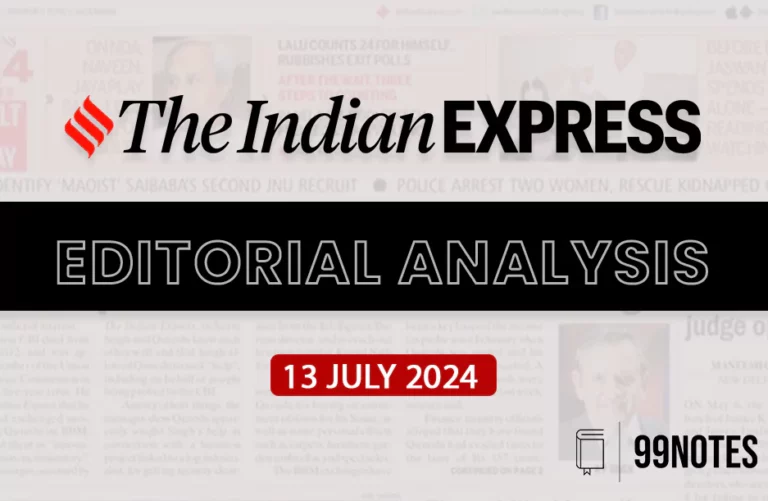19 July 2023 : Indian Express
Indian Express
19-July–2023
The Indian Express, CSE candidates can stay informed about current events and developments in India and around the world.
1. An economy more future-ready
Prelims: Indian Economy
Mains: GS-II< Indian Economy and Inclusive Growth and Arising from It>
Context:
- With Covid- 19 receding and, hopefully, with Russia-Ukraine War coming to an amicable end soon, India needs to chalk out her future growth strategy.
- The broad objective must be to raise the per capita income, estimated in 2022-23 at $2,379, by almost six times over the next 25 years.
- That will enable people to have a higher standard of living and eliminate poverty.
- India needs to grow at 7 percent for the next 25 years to raise incomes. The bulk of the investment to make this happen will have to be raised from within the country.
Current Economic Growth of India
- According to the Economic Survey 2022-2023: India is to witness GDP growth of 6.0% to 6.8% in 2023-2024, depending on the trajectory of global economic and political development.
- Indian GDP is expected to decrease to 6.3% from 6.6% in FY23/24, according to the World Bank.
-
- Growth is expected to be constrained by slower consumption growth and challenging external conditions.
- Rising borrowing costs and slower income growth will weigh on private consumption growth, and
- government consumption is projected to grow at a slower pace due to the withdrawal of pandemic-related fiscal support measures.
- India’s economy is one of the fastest-growing in the world and is anticipated to continue to grow at this rate to meet its goal of achieving the status of a high-middle-income country by 2047, the year of the country’s 100th anniversary of independence.
- India is also dedicated to making sure that its future growth trajectory is prepared to handle the problems caused by climate change and is consistent with its objective of having net-zero emissions by 2070.
What is needed for a Continuous Growth of 7% for the next 25 years?
- An incremental capital-output ratio (ICOR) of 4.
- ICOR explains the relationship between the level of investment made in the economy and a subsequent increase in GDP.
- A lower ICOR is preferred as it shows that a country’s production is more efficient.
- Where the ratio of 4 is assumed, based on improved efficiency in the use of capital of the country.
- The ration was law in the early years of this century during the high-growth period. It has subsequently increased.
- Excluding two outlier years namely, 2019- 20 and 2020-21, the average ICOR over five years from 2016-17 to 2022-23 is estimated to be 4.65.
- ICOR explains the relationship between the level of investment made in the economy and a subsequent increase in GDP.
- ICOR is dependent on many factors including technology. The required investment rate in the next 25 years may be in the range of 30-32 percent of the GDP.
- Gross Fixed Capital Formation rate of 28 percent.
- According to the latest release of the National Statistics Office (NSO), the Gross Fixed Capital Formation (GFCF) rate in current prices for 2022-23 is 29.2 percent of GDP.
- GFCF referred to as “investment,” is the net result of producing such assets for producers’ use and acquiring such assets (including the purchase of used assets).
- To increase the GFCF, it is necessary to increase the investment by the business sector of both co-operate and non-co-operate must increase.
- Investment must flow into important sectors and segments to promote growth and employment generation.
- Foreign Direct Investment (FDI) should also be promoted in the newly emerging technological sectors.
- According to the latest release of the National Statistics Office (NSO), the Gross Fixed Capital Formation (GFCF) rate in current prices for 2022-23 is 29.2 percent of GDP.
What are the Challenges?
Global Scenario
- The Ukraine-Russia conflict will be a strong negative factor for growth where the overall climate for peace is necessary for growth.
- Supply disruptions of critical imports like oil can cause a severe setback not only to developing countries but also to developed countries.
- The attitude of some countries toward global trade;
- The World Trade Organisation (WTO) was set up to create an environment of low tariffs and restrictions.
- But developed countries that earlier preached to the developing countries to adopt a free trade model, are backing out for one reason or another and putting restrictions on imports.
- This is taking place at a time when emerging nations like India are getting ready to enter the global marketplace.
- Developed nations should consider the domestic causes of their current situation, such as the rising unemployment rate.
Domestic Scenario
- India broke with its past in 1991 when it moved to a more market-oriented economy.
- Several countries— notably South Korea earlier and China more recently—achieved high growth over several decades by focusing on exports. But export-led growth strategy may not work for India, particularly in the context of the changed global trade situation.
Solutions: India Needed a Multi-dimensional Strategy
- Indian emphasis should be on agriculture and related activities, manufacturing, and export.
- Increase the ability to adopt new technologies.
- India must have much less difficulty in absorbing Artificial Intelligence (AI)and its ramifications. But that will have an impact on the industrial structure and, perhaps, employment.
- AI can increase productivity and output not necessarily jobs which is not good for populous countries like India.
- India needed to re-orient our education system to enable students to acquire the required skills and identify labor-intensive economic activities.
- We have to reckon with a lower employment elasticity for output.
- The impact on output because of environmental considerations like bringing down pollution, including the level of carbon, can have an output effect.
- The argument made by developing nations that they should bear the majority of the burden for pollution reduction is valid.
- By the Developed economies that have heavily exploited natural resources during the past 150 years.
- India will still be responsible for some of the costs. In this situation, a high yearly growth rate of 8% might have to be disregarded.
- India should be able to meet our multiple objectives including reducing inequality and poverty within the framework of an annual growth of 6 to 7 percent.
- Issues related to the basic income need to be resolved.
- The level of basic income and the coverage of beneficiaries have to be determined taking into account certain normative considerations and the capabilities of the fisc.
- We should be prepared to cut down on the basic subsidies other than the food subsidies.
- India has developed a reasonably robust and diverse economy during the last 75 years.
- India currently has the fifth-largest economy, which is an achievement, but in terms of GDP (nominal) per capita, it is currently ranked (2022) 149th out of 194 countries. So, we still have a way to go.
- To improve the economy, growth is crucial.
- Although the external situation is not encouraging as of now a 6 to 7% growth is continuously still possible if the strategy is correct by creating an appropriate investment climate.
For Enquiry

21 July 2023 : Daily Quiz

21 July 2023 : PIB

21 July 2023 : The Hindu Editorial Notes PDF

21 July 2023 : Daily Current Affairs

20 July 2023 : Daily Quiz

20 July 2023 : Daily Current Affairs

20 July 2023 : PIB

20 July 2023 : The Hindu Editorial Notes PDF

19 July 2023 : Daily Quiz

19 July 2023 : Indian Express
Daily Quiz 21 July 2023 : Daily Quiz 21 july 2023 : Daily Quiz…
PIB 21 July 2023 : PIB PRESS INFORMATION BUREAU
21-July-2023
Daily Current Affairs For UPSC ,The PIB ( Press Information Bureau…
The Hindu 21 July 2023 : The Hindu Editorial Notes PDF The Hindu Editorial
21-July-2023
Daily Current Affairs For UPSC ,The Hindu Editorial Summary
Facebook-f
Twitter
Youtube
1. No…
Daily Current Affairs 21 July 2023 : Daily Current Affairs DAILY CURRENT AFFAIRS
21-July-2023
Daily Current Affairs For UPSC ,Daily Current affairs of The hIndu…
Daily Quiz 20 July 2023 : Daily Quiz 20 july 2023 : Daily Quiz…
Daily Current Affairs 20 July 2023 : Daily Current Affairs DAILY CURRENT AFFAIRS
20-July-2023
Daily Current Affairs For UPSC ,Daily Current affairs of The hIndu…
PIB 20 July 2023 : PIB PRESS INFORMATION BUREAU
20-July-2023
Daily Current Affairs For UPSC ,The PIB ( Press Information Bureau…
The Hindu 20 July 2023 : The Hindu Editorial Notes PDF The Hindu Editorial
20-July-2023
Daily Current Affairs For UPSC ,The Hindu Editorial Summary
Facebook-f
Twitter
Youtube
1. A…
Daily Quiz 19 July 2023 : Daily Quiz 19 july 2023 : Daily Quiz…
Indian Express 19 July 2023 : Indian Express Indian Express
19-July–2023
The Indian Express, CSE candidates can stay informed about current…




